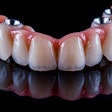Dr. Dan Butterman is back with another great clinical tip, courtesy of CDOCS, that will boost the acumen of any dentist.
 Dr. Dan Butterman.
Dr. Dan Butterman.
This week, Dr. Butterman is focusing on prepolishing zirconia and offering a new way that dentists can achieve the look they want for their patients.
"Zirconia has become a widely popular material, mainly because it's such a strong, versatile material. We can use it in so many different situations," Dr. Butterman says in the video below.
"The typical workflow with zirconia is that after we sinter it, we then polish the material before placing it in the patient's mouth. The issues that we can run into by doing it this way is that the scratches from the bur marks can be very difficult to remove. When the material is already sintered and so hard, we also have the potential problem of causing a pearling effect or getting an opalescence that we don't want in the zirconium material," he said.
Knowing that dentists often face an issue with zirconia, Dr. Butterman offers a solution.
"So we have a huge advantage if we can take the material before we've sintered it and it's in its soft state and try and polish it at this point. The goal is to very quickly remove the sprue and then, in just a matter of a minute or two, remove all the scratch marks, get the material to be very smooth so that after the sintering we have very, very little work to do," he said.
Dr. Butterman also shares what he uses in his practice to get the right effect with zirconia.
"Typically we're going to use the Misinger polishing kit, and I'm going to use the spiral polishers from this kit. I usually avoid the coarse step, because that's just going to be a little bit too aggressive. It's going to remove more material than I'd like.
"I'm going to start with the medium spiral polisher, and I'll polish the entire restoration except the contacts. Then I'm going to come in with a fine spiral polisher, and that's going to remove the remaining amount of bur marks that we have, and we'll have a very smooth, even shiny surface when we're done with that.
"If we want to take it even a step further, after the sintering process, we can use a DiaShine polishing paste. This is from VH Technologies. This is a diamond-impregnated paste, and we use this with a Robinson brush just to bring up the luster a little bit of the material," Dr. Butterman said.
Check out the video below from Dr. Butterman. You can also visit CDOCS to learn more, and learn more about CDOCS' hands-on workshops.



















